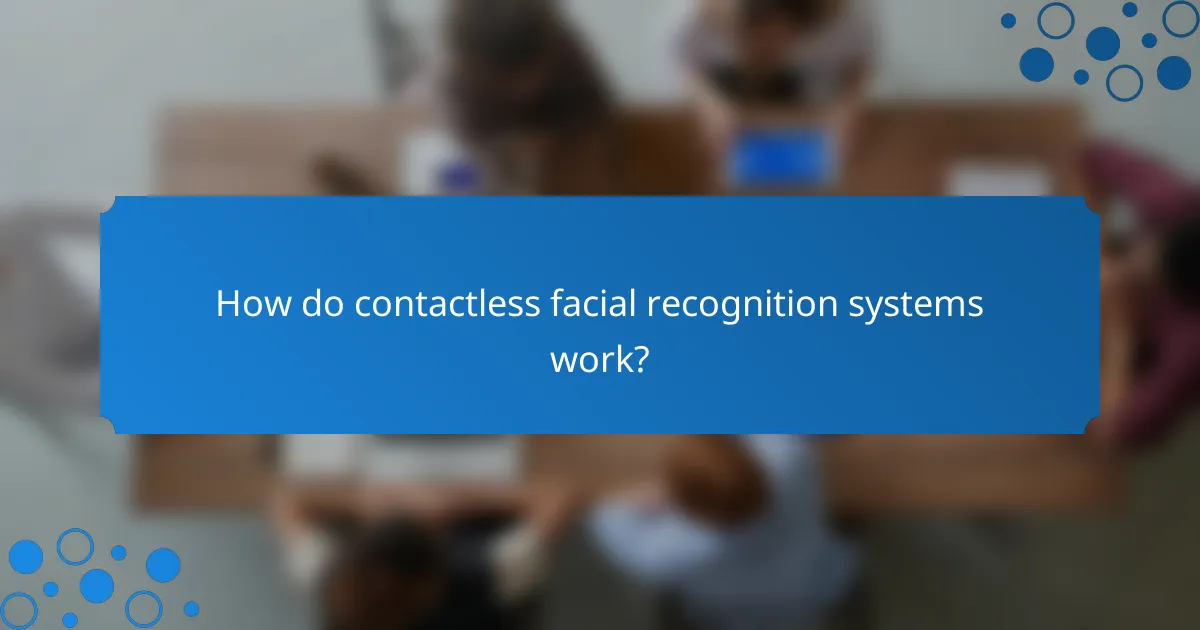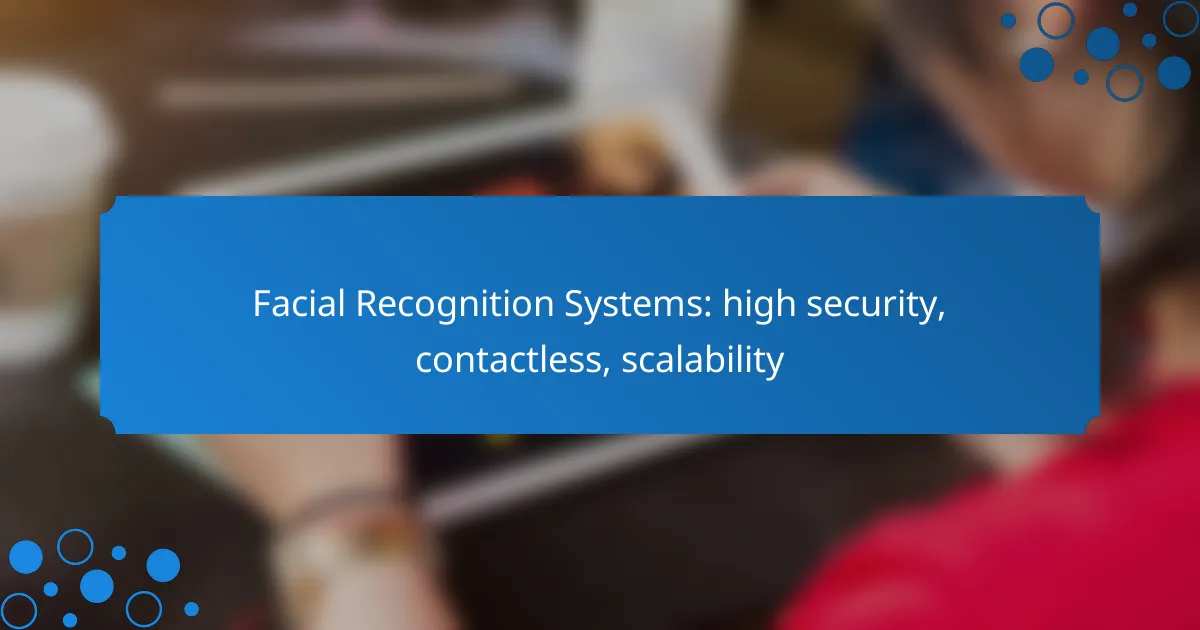Facial recognition systems are revolutionizing security measures by providing high accuracy and speed while ensuring compliance with privacy regulations. Designed for critical environments like airports and financial institutions, these contactless systems capture facial features from a distance, enabling seamless identification without physical interaction. Additionally, they offer scalable solutions tailored to meet the diverse needs of organizations, whether through cloud-based services or on-premises installations.

What are the best facial recognition systems for high security in Canada?
The best facial recognition systems for high security in Canada include advanced technologies that ensure accuracy, speed, and compliance with privacy regulations. These systems are designed for high-stakes environments such as airports, government buildings, and financial institutions, where security is paramount.
NEC NeoFace
NEC NeoFace is a leading facial recognition system known for its high accuracy and speed, making it suitable for high-security applications. It utilizes advanced algorithms to analyze facial features and can process images in real-time, which is crucial for security monitoring in busy environments.
This system is compliant with Canadian privacy laws, ensuring that user data is handled responsibly. NEC NeoFace is often used in law enforcement and border control, providing a reliable solution for identity verification.
FaceFirst
FaceFirst offers a robust facial recognition platform that excels in high-security scenarios. It features a user-friendly interface and integrates seamlessly with existing security systems, allowing for quick deployment and scalability.
This system is particularly effective in retail and public safety sectors, helping to identify individuals in real-time. FaceFirst emphasizes data protection and adheres to Canadian regulations, making it a trusted choice for organizations prioritizing security and privacy.
Clearview AI
Clearview AI is known for its extensive database and powerful facial recognition capabilities, making it a prominent option for high-security needs. It allows users to match faces against a vast repository of images, which can be beneficial for law enforcement and security agencies.
While Clearview AI offers significant advantages in identification accuracy, it has faced scrutiny regarding privacy concerns. Organizations considering this system should ensure compliance with Canadian privacy laws and weigh the ethical implications of its use.

How do contactless facial recognition systems work?
Contactless facial recognition systems operate by capturing and analyzing facial features from a distance, allowing for identification without physical interaction. These systems utilize advanced camera technology and image processing algorithms to quickly and accurately recognize individuals in various environments.
Camera technology
Camera technology is crucial for the effectiveness of contactless facial recognition systems. High-resolution cameras with wide dynamic range capabilities can capture clear images in diverse lighting conditions, which is essential for accurate recognition. Many systems employ infrared cameras to enhance performance in low-light scenarios.
Additionally, the use of multi-camera setups can improve accuracy by providing multiple angles of a subject’s face. This redundancy helps mitigate issues caused by occlusions or poor angles, ensuring a higher success rate in identification.
Image processing algorithms
Image processing algorithms play a vital role in transforming captured images into recognizable data. These algorithms analyze facial features such as the distance between eyes, nose shape, and jawline contours to create a unique facial signature. Machine learning techniques are often employed to improve recognition accuracy over time.
Common algorithms include convolutional neural networks (CNNs) and support vector machines (SVMs), which can process images rapidly and efficiently. When selecting a facial recognition system, consider the algorithm’s speed and accuracy, as these factors significantly impact performance in real-world applications.

What are the scalability options for facial recognition systems?
Facial recognition systems offer various scalability options to accommodate different organizational needs and growth. These options primarily include cloud-based solutions and on-premises installations, each with distinct advantages and considerations.
Cloud-based solutions
Cloud-based facial recognition systems provide flexibility and ease of scaling as they can be quickly adjusted to meet increasing demands. Organizations can access powerful computing resources without the need for extensive hardware investments, making it cost-effective for many businesses.
These solutions typically operate on a subscription model, allowing users to pay for what they need. This can range from a few hundred to several thousand dollars per month, depending on the features and volume of usage. Additionally, cloud providers often ensure compliance with data protection regulations, which is crucial for handling sensitive biometric data.
On-premises installations
On-premises facial recognition systems involve installing hardware and software directly within an organization’s infrastructure. This option offers greater control over data and security, making it suitable for industries with stringent privacy requirements.
While initial costs can be higher due to hardware purchases and maintenance, organizations benefit from reduced ongoing costs once the system is fully operational. Scalability can be achieved by upgrading hardware or adding new software features, but this may require more planning and investment compared to cloud solutions.

What are the key benefits of using facial recognition systems?
Facial recognition systems offer significant advantages such as enhanced security, contactless interactions, and scalability for various applications. These systems utilize advanced algorithms to identify individuals quickly and accurately, making them valuable in sectors like security, finance, and retail.
Enhanced security
Facial recognition technology significantly boosts security by providing accurate identification and verification of individuals. It can be integrated into access control systems, allowing only authorized personnel to enter secure areas, thus reducing the risk of unauthorized access.
For example, many airports and government buildings now employ facial recognition to enhance security measures. These systems can process images in real-time, identifying individuals within seconds, which is crucial in high-security environments.
Improved user experience
Facial recognition systems streamline user interactions by enabling contactless access and services. Users can gain entry to facilities or complete transactions without the need for physical cards or PINs, making the process faster and more convenient.
In retail, for instance, facial recognition can personalize shopping experiences by recognizing returning customers and offering tailored recommendations. This not only enhances customer satisfaction but also increases operational efficiency.

What factors should be considered when choosing a facial recognition system?
When selecting a facial recognition system, key factors include integration capabilities, data privacy compliance, and the specific security needs of your organization. Evaluating these aspects ensures the system aligns with operational requirements and legal standards.
Integration capabilities
Integration capabilities refer to how well the facial recognition system can work with existing security infrastructure, such as cameras, access control systems, and software platforms. A system that easily integrates can streamline operations and reduce implementation costs.
Look for systems that support common protocols and APIs, allowing for seamless connectivity. For example, a system that can integrate with cloud services may offer enhanced scalability and remote access.
Data privacy compliance
Data privacy compliance is crucial, especially in regions with strict regulations like the EU’s GDPR or California’s CCPA. Ensure the facial recognition system adheres to these laws to avoid legal repercussions and protect user data.
Evaluate how the system handles data storage, consent management, and user rights. Systems that provide transparency in data usage and allow users to opt-out can enhance trust and compliance.

What are the challenges of implementing facial recognition technology?
Implementing facial recognition technology presents several challenges, including privacy concerns and regulatory hurdles. These issues can significantly impact the deployment and acceptance of such systems in various environments.
Privacy concerns
Privacy concerns are a major challenge when deploying facial recognition technology. Many individuals worry about how their biometric data is collected, stored, and used, leading to potential misuse or unauthorized access. This anxiety can result in public backlash against organizations that utilize these systems.
To address privacy issues, organizations should implement strong data protection measures and ensure transparency about their data usage policies. Regular audits and compliance with privacy standards can help build trust with users and mitigate concerns.
Regulatory hurdles
Regulatory hurdles can complicate the implementation of facial recognition technology. Different countries and regions have varying laws governing the use of biometric data, which can create challenges for companies operating in multiple jurisdictions. For example, the European Union has stringent regulations under the General Data Protection Regulation (GDPR) that impact how facial recognition can be used.
Organizations should stay informed about local regulations and ensure their systems comply with applicable laws. Engaging with legal experts can help navigate the complex landscape of biometric data regulations and avoid potential fines or legal issues.

How does facial recognition technology compare to other security measures?
Facial recognition technology offers a unique blend of high security, contactless operation, and scalability that distinguishes it from traditional security measures. Unlike methods such as passwords or physical keys, facial recognition relies on biometric data, making it harder to spoof and more user-friendly.
Versus biometric authentication
Facial recognition is a form of biometric authentication, but it stands out due to its contactless nature. While other biometric methods, such as fingerprint or iris scanning, require physical interaction, facial recognition can be performed at a distance, enhancing convenience and speed in security checks.
When comparing effectiveness, facial recognition systems generally offer higher accuracy rates, especially in well-lit environments. However, they can be affected by factors like lighting conditions, angles, and facial obstructions, which may not impact other biometric systems as significantly.
In practical terms, organizations should consider the specific use case when choosing between facial recognition and other biometric methods. For instance, in high-traffic areas like airports, facial recognition can streamline processes, while fingerprint scanning might be more suitable for secure access to individual devices. Always ensure compliance with local regulations regarding data privacy and biometric data handling.
